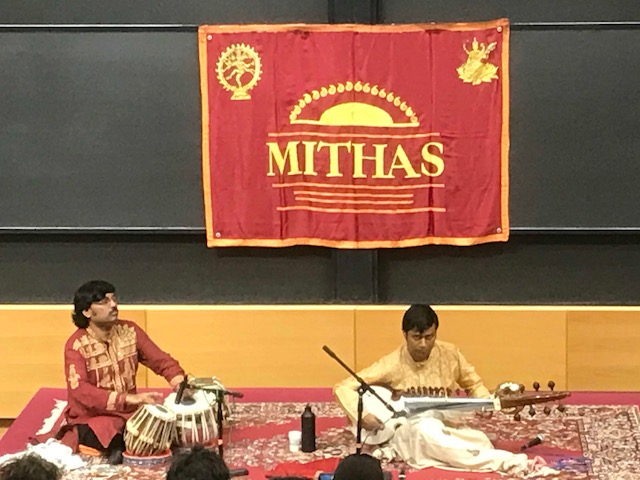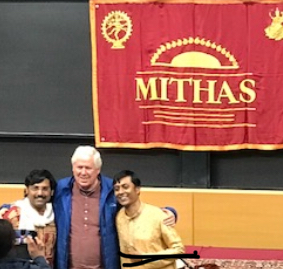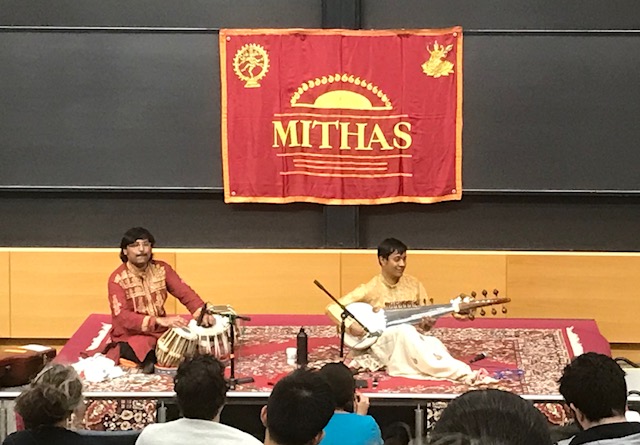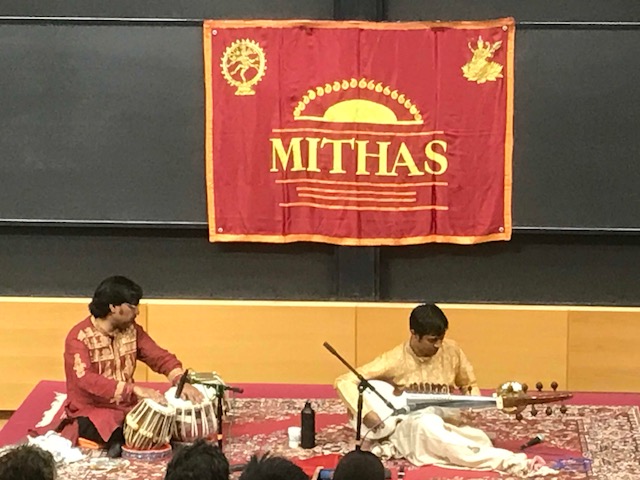Contribute
| In Conversation With Apratim Majumdar |
Shuchita Rao
11/22/2017
MITHAS (MIT Heritage Arts of South Asia) presented Kolkatta based artists Shri Apratim Majumdar on the sarod instrument accompanied by Shri Amit Chatterjee on the tabla Saturday, November 4, 2017. Shri Majumdar, an empaneled artist with the Indian Council for Cultural Relations (ICCR) has learned music from Shri Rabin Ghosh (disciple of Maihar’s Baba Allaudin Khan) for over 19 years, with Shri Partho Sarothy (disciple of Ustad Dhayanesh Khan and Pandit Ravi Shankar) for three years and is currently a disciple of Dr. Pradip Kumar Chakraborty who is one of the senior most disciples of Bharat Ratna, the late Pandit Ravi Shankar. He holds a Master’s degree in music from Pracheen Kala Kendra, Chandigarh. On the evening of November 4, Shri Majumdar, accompanied by the gifted Shri Amit Chatterjee (son of the renowned Punjab and Farukkhabad gharana tabla player Sri Sankha Chatterjee) presented Ragas Kaushi Kanhra, Malgunji and a ragamaala (garland of ragas). Shri Majumdar will be presenting a recital at Learnquest Baithak (125 Prospect St, Framingham, MA) on Saturday, Nov 25 at 7pm. Shuchita Rao of Lokvani spoke to Shri Majumdar about his journey in music. Q. What attracted you to the Sarod instrument? A. I initially learned vocal music from my mother, who had trained under the late Ustad Bade Ghulam Ali Khan’s disciple, Smt. Meera Banerjee. My father loved listening to music and was fond of collecting audio cassettes. We listened to a variety of music on the audio cassettes. I loved the sound of Ustad Ali Akbar Khan’s Sarod so much that I requested my father to find me a Sarod teacher. Q. It must have been more difficult to learn to play the Sarod than to sing? A. I was ten years old. I became so emotional about wanting to learn playing the Sarod that I never for once thought about how difficult it was to learn it. I give great credit to my Guruji – he always encouraged and said “Keep playing – you will get how to play the Sarod.†Q. As a young child, did you find classical music appealing? A. I would say, yes. I used to practice what my Guruji taught me but I also explored other genres on my own. I used to learn and play Bangla songs and Rabindra Sangeet without any teacher’s help. Q. Was your father into music or any other form of art? Do you have siblings? A. My father was very fond of music but did not have the financial resources to learn music. He listened to music through his audio cassette collection and so, there was an atmosphere of music in our home. My mother was not a professional singer but she sang Khayal and Nazrul-Geethi. I was a good painter and dabbled in water color paintings. At one time, I thought I would take formal lessons in making oil paintings. However, all my time went into learning and playing the Sarod. I do not have any siblings. Q. You play in the Dhrupadee Beenkari style. Could you describe that style for us? A. Mainly, when expanding on a raga, I must show twelve angas and must play in a smooth manner without jerky movements. The twelve steps are alaap and jod in Vilambit, Madhya-vilambit, Drut-vilambit tempos, lori (work with playing chikaari strings), lad guthaav (weaving of musical phrases), lad lapet (playing musical phrases with gamak), thok jhaala (accented jhaala phrases) and seedha jhaala (simple, straightforward jhaala), ladanth (playing in a 4-4 meter) and dhua-maata (play a musical theme in three octaves and end with a specific closing pattern of notes). Q. Can you tell us about a favorite instrumental technique you learned from a teacher? A. The interesting thing is that I used to resent it a lot when my teacher used to teach me the “Krintan†technique of playing grace notes. My teacher understood my resentment but laughed it off and said that I would understand its value later in life. Now, I find that it is the most useful technique I have needed and use it all the time. Q. Have you played music in feature films or composed for them? A. I have played the Sarod for hundreds of films and have composed music for about four feature films that are now playing in film festivals. As a freelancer, I have composed and also provided music for dozens of Bangla and Hindi documentary as well as films produced by students of West Bengal state run film institute. Q. You recently recorded music for a clarinet student studying at the Julliard School of music in New York. What in your opinion is the main difference between Indian and Western music? A. In my opinion, a key difference is that Indian classical musicians start from a slow tempo and gradually increase tempo while Western musicians maintain the same tempo from start to finish. Q. Is the performing arts a competitive market? Do you ever get discouraged when you find it difficult to get an opportunity to perform? A. Kolkatta has become a factory for producing artists. You cannot believe how many instrumentalists and percussionists we have. I feel proud to belong to such a place but that also means I get less opportunities because everybody wants to perform in a concert. I do not get discouraged because I simply treat the presence of other aspiring artists as an occupational hazard. Q. How many countries around the world have you given performances in? A. Perhaps a dozen or more in Europe (Germany, France, Italy, Austria and more), Asia and North America. I look forward to visiting the United Kingdom and Australia among other continents. Q. What are your plans for the future? A. My future plans are simply to live, to play music and to teach students. Q. Is there an important life-lesson you have learned from music that you would like to share with our music lovers in Boston? A. “If you are talented in music, don’t be too proud of yourself†is the life lesson that I have learned from music. Musical talent is important and I respect it. However, I give more importance to regular practice and riyaaz. I believe that someone without significant talent can shine if they work hard and are committed to riyaaz.
You may also access this article through our web-site http://www.lokvani.com/



